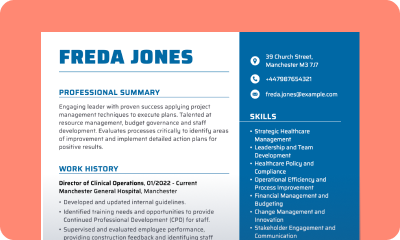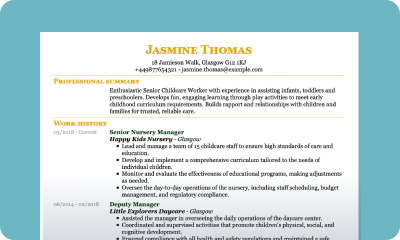- Our customers have been hired by : *Foot Note
Your university CV is the first step towards your professional future — and it deserves to look the part.
If you’re looking for a CV template for university students that recruiters actually notice, you’re in the right place. Our expertly designed university student CV examples and templates show exactly how to highlight your studies, transferable skills, and achievements, even if you have little or no work experience.
In this guide, you’ll find:
- Sample university student CVs – Real examples that show what works.
- University student CV templates – Professionally designed layouts you can customise.
- University student CV format – The best format for students and recent graduates.
- How to write a university student CV – Step-by-step CV structure and writing guide.
- Dos and don’ts for a university student CV – Common pitfalls and how to avoid them.
SEARCH ALL CV EXAMPLES
CV example for a university student
This university student CV example shows how to structure your information clearly and make the most of your academic background. The layout places key skills and education at the top, helping employers see your strengths straight away (ideal for students with limited work experience).
Alexandra Bennett
Manchester, UK
07911 845 332
alexandra.bennett@email.com
LinkedIn: linkedin.com/in/alexandrabennett
PROFESSIONAL SUMMARY
Motivated and detail-oriented University of Manchester Business Management student with strong analytical and teamwork skills. Experienced in balancing academic studies with part-time work and extracurricular leadership roles. Keen to apply my organisational, communication, and problem-solving abilities in a summer internship or graduate-level business support role.
SKILLS
- Data analysis and reporting (Excel, SPSS)
- Digital marketing and social media strategy
- Project coordination and deadline management
- Customer engagement and problem-solving
- Business writing and professional presentations
- Microsoft Office 365 and Canva
- Market research and insight generation
- Team leadership and collaboration
EDUCATION
September 2022–Current
University of Manchester, England
Bachelor of Arts Business Management
WORK HISTORY
June 2023–current
Tesco Express – Manchester
Customer Assistant
- Maintained 98% customer satisfaction through efficient service and issue resolution.
- Managed restocking and inventory using POS systems.
- Trained two new team members on store operations and compliance.
- Monitored daily sales trends and shared feedback with supervisors to improve product placement and promotional visibility.
October 2022–current
University of Manchester – Manchester
Student Ambassador
- Delivered presentations to groups of 100+ prospective students.
- Supported digital marketing campaigns for open days and webinars.
- Collaborated with admissions staff to improve online student engagement.
- Designed content for student social channels, increasing event sign-ups by 25%.
The best format for a university student CV
When you are still studying or just starting in your career, a skills-based CV format is the best choice. Unlike a traditional chronological CV, which lists your work history in date order first, a skills CV focuses on what you can do rather than where you have worked.
This format is ideal for university students because it highlights your transferable skills, academic achievements, and extracurricular experience, even if you have limited work history. You can group your experience under key skill areas such as communication, research, teamwork and digital literacy, then use short examples from coursework, projects, volunteering, or part-time jobs to show how you have applied each one.
A skills CV helps you:
- Showcase relevant strengths developed through university life and study
- Draw attention to achievements rather than gaps in work history
- Present your abilities in a way that aligns directly with job or internship requirements
- Emphasise potential and capability, two qualities employers value in students and graduates
In contrast, a chronological CV focuses on your work history. It lists jobs and placements in date order, starting with the most recent position. This format is useful for people who already have steady work experience to show, as it highlights career progression over time.
How to write your university student CV
This simple step-by-step guide to writing a CV will show you how to highlight your strengths, present your education effectively, and create a CV that shows employers your potential.
University student CV structure

Your CV should be as clear and well-organised as your best set of study notes. Recruiters often scan applications quickly, so keep your layout tidy and make every section easy to find. A clean, professional structure helps them spot your potential at a glance.
Here is how to structure your university student CV:
- Name and contact details – Place these at the top so employers can reach you easily. A photo is not required in the UK.
- Personal statement (profile) – Write a short summary of your key achievements, skills, and career goals.
- Key skills – Focus on transferable abilities such as communication, organisation, research, teamwork, or technical knowledge.
- Education – Highlight your current degree, relevant modules, academic projects, and earlier qualifications.
- Work experience – Include part-time jobs, internships, or volunteering, listed in chronological order.
Step 1: Write your university student CV summary
Your CV summary, also known as your personal statement, appears just below your contact details. It is a short, focused paragraph that introduces who you are, what you are studying, and what you can offer to an employer.
Even if you do not have much work experience, your summary is your chance to make a strong first impression by focusing on your strengths, achievements, and ambitions.
What to include:
- Who you are – e.g. “Final-year psychology student at the University of Leeds with a strong interest in organisational behaviour.”
- Key strengths – e.g. “Experienced in research, data analysis and public speaking through academic projects and society involvement.”
- Goal or focus – e.g. “Looking to apply analytical and communication skills in a graduate role within human resources or business development.”
Tip: Tailor your profile to each opportunity. Use keywords from the job description, such as data analysis, customer service, team collaboration or research skills, to show employers that you match their requirements.
Step 2: Add your key skills
The skills section gives employers a quick overview of what you can do. It should sit near the top of your CV, just below your personal statement, so it’s one of the first things recruiters see.
Even if you don’t have much professional experience yet, you already use valuable skills every day, through university projects, part-time jobs, volunteering, or group work. Choose abilities that match the role you’re applying for and show how you can make an impact.
What to include:
- Technical or subject-specific skills – e.g. programming languages, lab techniques, data analysis, design tools or research methods.
- Soft skills – such as communication, organisation, teamwork, leadership, or problem-solving.
- Personal strengths – like adaptability, creativity, or attention to detail, which show you’ll fit well into a team.
Example: Key skills for a university student CV
- Research and data analysis (SPSS, Excel)
- Written and verbal communication
- Time management and multitasking
- Customer service and client support
- Social media content creation
- Team collaboration and project coordination
- Critical thinking and problem-solving
- Adaptability and fast learning
Tip: Keep your skills section concise; aim for 6–10 bullet points relevant to the role. Avoid listing generic traits like “hard-working” or “motivated.” Instead, choose specific skills you can back up with examples elsewhere in your CV.
Step 3: Add your education
For most university students, the education section is the strongest part of the CV. It shows your qualifications, the skills you’ve developed through study, and your commitment to learning.
Place this section near the top of your uni student CV (either below the CV summary or after the key skills section), especially if you don’t have much professional experience yet.
What to include
- University and degree – State your university name, degree title, and study dates. Add your predicted grade if available.
- Key modules or projects – Mention a few that relate to the role you’re applying for.
- Research or dissertation topic – Include it if it’s relevant to your chosen field.
- Earlier qualifications – List A-levels or equivalent, plus GCSEs briefly if space allows.
Tip: Use your education section to show employability skills. For example, project work demonstrates organisation and teamwork, while essays and presentations highlight communication and research abilities.
Example: Education section
University of Leeds — BA (Hons) English and Media
September 2021 – Present
- Predicted: 2:1
- Key Modules: Digital Journalism, Media Ethics, Storytelling and Audience Engagement
Greenfield Sixth Form College
A-Levels: English Literature (A), History (B), Sociology (B)
Completed: 2021
Step 4: Add your work experience
Your work experience section shows employers how you’ve applied your skills in real situations. Even if you haven’t had a full-time job yet, you can include part-time work, volunteering, internships, placements, or any projects where you took responsibility and achieved results.
List your experience in reverse chronological order (most recent first) and include the job title, organisation name, location, and dates. Use short bullet points to describe what you did and the skills you developed.
What to include
- Part-time jobs – for example, customer service, retail, or hospitality roles.
- University or course placements – such as lab work, teaching practice, or marketing projects.
- Volunteering and extracurricular work – anything that shows teamwork, initiative, or leadership.
- Freelance or project work – if relevant to your field of study.
Tip: Use active verbs like organised, supported, delivered, improved and created to describe your responsibilities. Focus on what you achieved or learned, rather than just listing tasks.
Example: Work experience section
Marketing Intern — Bright Ideas Agency, Leeds
June 2023 – August 2023
- Assisted with social media scheduling and content creation across Instagram and LinkedIn.
- Helped plan and promote a local awareness campaign that reached over 5,000 users.
- Carried out competitor research and presented insights to the marketing team.
Student Ambassador — University of Leeds
October 2022 – Present
- Supported open days and online Q&A sessions for prospective students.
- Represented the university professionally and provided campus tours.
- Collaborated with the admissions team to improve visitor experience and engagement.
Step 5: Add additional information (optional)
The final section of your university student CV is where you can include any extra details that help employers understand more about you as a person.
This could cover achievements, hobbies, languages, or extracurricular activities that highlight your initiative and transferable skills.
What to include
- Achievements – such as academic awards, society leadership roles, or competition results.
- Hobbies and interests – choose those that show useful qualities like teamwork, creativity, or commitment.
- Languages – mention any you speak fluently or at an intermediate level.
- Volunteering – briefly include unpaid roles that show community involvement or leadership.
Example: Additional information section
Achievements and Interests
- Winner of the “Student Enterprise Challenge 2023”, University of Leeds.
- Awarded a Distinction in Digital Skills for Work, 2022.
- Member of the university debate team, developing confidence and public speaking skills.
Tip: If you already have extensive experience or your CV fills most of two pages, you can leave this section out altogether. Recruiters prefer concise, focused applications.
Dos and don’ts for a university student CV
Creating a strong university student CV is all about showing care, focus and attention to detail. Recruiters can quickly spot when a CV has been rushed, so take time to make yours accurate, relevant, and professional.
A recruiter will almost always notice if you’ve sent a generic CV without reading the job advert carefully. To give your university student CV the best chance of passing scanning software such as ATS, always include relevant keywords and phrases from the job description. This helps your CV match the employer’s requirements and shows you’ve taken the time to customise your application.
Presentation matters. Use consistent fonts, clear headings and balanced spacing so your CV looks organised and professional. Recruiters spend seconds scanning each CV, so make it simple for them to find your best points.
Keep your CV concise and easy to scan. Aim for one page if you are still at university, or two pages if you already have more experience. Avoid large blocks of text and use short sentences or bullet points to make key details stand out. A clean, well-structured layout makes it easier for recruiters to see your strengths quickly.
Once you’re studying for a degree, GCSE and early school awards become less relevant. Prioritise your university work, placements, or extracurricular experiences that reflect your current skills and ambitions.
Your university student CV questions answered
Do you need a CV for university?
Yes! You need a CV for university if you want to apply for any part-time roles while you’re studying. It’s also highly useful for graduate schemes, with applications typically starting up to a year before you actually graduate.
How do I write a CV for a university UK?
A CV for university is a document that outlines your brief career to date, whether that’s made up of part-time roles, summer jobs, or voluntary work. You’ll need to include some essential information:
- Contact details
- Personal statement
- Work experience
- Skills
- Education
How to write a CV for applications in university?
To write a CV for applications while you’re in university, you should consider what employers are looking for. That includes:
- Specialist technical expertise through your degree and work experience that will fit perfectly with the job description. For example, coding for a programmer job.
- Transferable capabilities honed during your time at college and university, such as the hard work, punctuality, and clear communication you can bring to a role. This is especially relevant in a CV for university students with no experience.
- Work experience in the field you’re applying to is always a big bonus.
- Passion for the role, and preferably, the company itself.
How do I make an undergraduate CV?
Whilst most university student CVs won’t include the same level of experience as an employee who’s been in the industry for over ten years, there are still many ways you can make an undergraduate CV impressive.
- Any work experience you can include is a must for a university student’s CV, as you’ll need to stand out.
- If you’re lacking in experience, a hobbies and interests section is a good way to reduce the focus on work history
- While you might not have your degree just yet, previous educational achievements like A-levels or BTEC Diplomas should also be included to support your most recent qualification.
- Take a look at some university student CV examples to see exactly how they’re set out and the kinds of details you’ll need to include.
How do you put university experience on a CV?
There are a few places to record your university experience on a CV:
- Your education history – This should include basic details, such as the name of the course and the course provider. Don’t be tempted to go into further detail here.
- Skills –Depending on the CV format you choose, this could include a short summary of skills you’ve picked up on your degree or, if you’re using a skills-based format, you can flesh out the skills you’ve learned in more detail, with examples.
- Hobbies and interests – If you decided to add this optional section, you could mention any university projects that demonstrate the core competencies of the job role.
- Cover letter –Outside of your CV, you can use the covering letter to highlight any details from your course modules that haven’t had the opportunity to shine in your university student CV.
Related Student CV Examples & Templates
Create your university student CV today
Creating your CV doesn’t need to feel like another stressful deadline. My Perfect CV builder creates a professional, tailored application in just a few minutes. Explore our expert-designed CV templates and real student CV examples to craft a document that showcases your skills, confidence and potential.
*The names and logos of the companies referred to above are all trademarks of their respective holders. Unless specifically stated otherwise, such references are not intended to imply any affiliation or association with myperfectCV.




